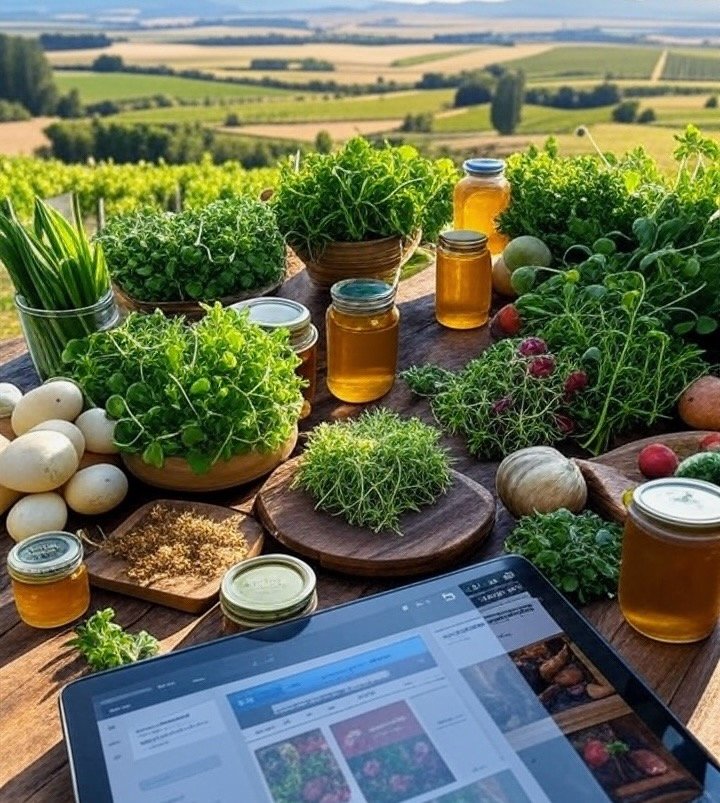Farmers are discovering a new way to connect with customers: the online farm shop. With Christchurch’s bustling food scene just a short drive away and a growing appetite for fresh, local produce, direct-to-consumer (DTC) sales are transforming how North Canterbury farmers do business. Setting up an online farm shop isn’t just a way to diversify income—it’s a chance to tell your farm’s story, build loyal customers, and keep more of the profits. Here’s how North Canterbury farmers and lifestyle block owners can get started, with practical steps to launch a thriving digital storefront.
Why Direct-to-Consumer Sales Matter
The rise of DTC sales reflects a shift in how people shop for food. Consumers today want transparency – where their lamb chops or heirloom tomatoes come from, who grew them, and how. North Canterbury, with its rich agricultural heritage and proximity to urban markets, is perfectly positioned to meet this demand. Whether you’re a sheep farmer, a beekeeper, or a lifestyle block owner growing microgreens, an online farm shop lets you bypass middlemen, from wholesalers to supermarkets, and sell directly to eager buyers.
The benefits are clear. By cutting out intermediaries, you can command higher prices for your goods. You also gain control over your brand, sharing the story of your sustainable practices or family-run operation. Plus, with Canterbury’s population growing and farmers’ markets thriving, there’s a ready audience hungry for your products. Even better, online platforms make it easier than ever to reach them, whether they’re local foodies or Auckland chefs sourcing premium ingredients.
Step 1: Define Your Products and Niche
Before you dive into building your online shop, take stock of what you can offer. North Canterbury’s diverse farms provide endless possibilities. Your products should reflect what sets your farm apart.
Consider niching down to stand out. Start small to keep things manageable. A curated selection of high-quality products is easier to market and fulfill than an extensive catalog. Once you’ve nailed down your products, set prices that reflect your costs (including labor and shipping) while staying competitive with local markets.
Step 2: Choose the Right Platform
Building an online shop doesn’t require a degree in web design—modern e-commerce platforms make it simple and affordable. For North Canterbury farmers, the goal is a platform that’s user-friendly, cost-effective, and flexible enough to handle local delivery or nationwide shipping.
Platforms let you showcase your products with photos, descriptions, and customer reviews. For a professional touch, invest in high-quality images—hire a photographer/videographer or use a smartphone with good lighting to capture your produce. Include details like “grown without pesticides” or “harvested within 24 hours of shipping” to appeal to North Canterbury’s eco-conscious buyers.
Step 3: Set Up Logistics and Payments
One of the biggest hurdles in DTC sales is logistics—how to get your goods from your farm to the customer’s table. Start by deciding your delivery range. Local delivery within Waimakariri or Hurunui is simplest, with many farmers offering free drop-offs for orders over $100. For broader reach, partner with other farmers and create a local delivery service. To keep perishable goods fresh, invest in insulated packaging.
Payment processing is another key piece. Most platforms integrate with Stripe or PayPal, which charge 2.9% + $0.30 per transaction. Offer multiple payment options, including credit cards and Afterpay, to cater to younger buyers. For local customers, consider adding a “pay on pickup” option to save on fees.
Don’t forget compliance. Ensure your products meet New Zealand’s food safety standards, particularly for meat or dairy. The Ministry for Primary Industries offers free resources for small producers.
Step 4: Market Your Farm Shop
Your online shop won’t sell itself—you need to spread the word. Luckily, North Canterbury’s tight-knit community and vibrant food culture make marketing both fun and effective. Start with social media, where platforms like Instagram and Facebook let you showcase your farm’s story. Post behind-the-scenes content – to build trust. Use hashtags to reach local foodies.
Email marketing is another powerful tool. Collect customer emails at checkout (most platforms offer opt-in forms) and send monthly newsletters with updates, like new products or recipes.
Don’t overlook local partnerships. Collaborate with restaurants or cafes to feature your products, or join forces with other farmers for a “North Canterbury Food Box” combining produce. Promote your shop at local farmers’ markets or community events, handing out flyers with a discount code for first-time buyers.
Step 5: Build Customer Loyalty
The real magic of DTC sales lies in turning one-time buyers into loyal customers. Start by delivering exceptional service—include a handwritten thank-you note with each order or a free sample, like a sachet of dried herbs with a veggie box. Follow up with a post-purchase email asking for feedback, and encourage reviews on your website to build trust.
Consider a subscription model to lock in recurring revenue. For example, offer a weekly or monthly veggie box for $50, customizable based on what’s in season.
Engage with your community to deepen connections. Host a farm open day, inviting locals to see your regenerative practices or taste your honey. Share your sustainability efforts – to resonate with North Canterbury’s eco-minded residents.
Getting Started Today
Launching an online farm shop may sound daunting, but it’s more accessible than ever. Start small—pick one or two products, set up a basic store, and test local delivery within Waimakariri. As you grow, expand your range, refine your marketing, and explore new markets.
In a region as fertile and connected as North Canterbury, an online farm shop isn’t just a business—it’s a way to share your passion with the world. Your farm has a story worth telling. So, grab your laptop, snap some photos of your harvest, and start building your shop today. Your customers are waiting.







